
Bands of hungry primeval men hunt gigantic prehistoric creatures in these fanciful Cup Noodle commercials from the early '90s. (Stop-motion animation by Kim Blanchette.)
[More here, including a mammoth, pterodactyl and giant warthog.]

Bands of hungry primeval men hunt gigantic prehistoric creatures in these fanciful Cup Noodle commercials from the early '90s. (Stop-motion animation by Kim Blanchette.)
[More here, including a mammoth, pterodactyl and giant warthog.]
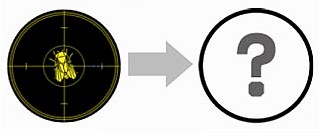 The marketing minds at Fumakilla, a pesticide manufacturer, have launched a gimmicky bug spray promotional campaign that makes use of heat-sensitive, color-changing stickers placed in urinals at public restrooms around Shinjuku station. Under ordinary, dry conditions, the special urinal stickers show a housefly in the crosshairs of a rifle scope, but as men take aim and relieve themselves on the stickers, the fly transforms into an advertising message.
The marketing minds at Fumakilla, a pesticide manufacturer, have launched a gimmicky bug spray promotional campaign that makes use of heat-sensitive, color-changing stickers placed in urinals at public restrooms around Shinjuku station. Under ordinary, dry conditions, the special urinal stickers show a housefly in the crosshairs of a rifle scope, but as men take aim and relieve themselves on the stickers, the fly transforms into an advertising message.
The stickers are printed with a layer of special, heat-sensitive ink developed by Pilot Ink. When the sticker is exposed to a certain amount of heat, this layer of ink becomes transparent, revealing an advertisement printed underneath. Dai Nippon Printing, who manufactured the stickers for Fumakilla, designed them to withstand the rigors of being placed in a public urinal for extended periods of time. Fumakilla says that in addition to serving as a form of advertising, the stickers provide men with a convenient target to aim for when using urinals, which leads to a cleaner restroom environment.
The company has also launched a website featuring a simple Flash game called "Ippatsu Meichu," which allows players to test their fly-shooting skills in a virtual lavatory. Make sure not to make a mess, though, or you'll get a visit from the angry toilet lady.
[Source: IT Media]
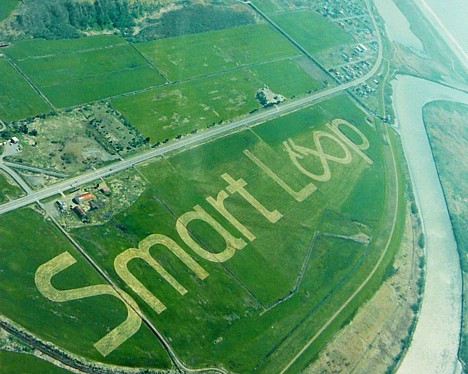
Next time you float past Hokkaido, look down upon the town of Urahoro. There in a field you will see a giant geoglyph that spells out the words "Smart Loop."
This crop circle message is the work of a highly advanced race of aliens Pioneer, which has taken shears to grass to promote its latest Smart Loop car navigation system. Pioneer spent a month working on the 1,000 x 200 meter (3,280 x 660 feet) ad, and has filed an application with Guinness to get it officially recognized as the world's longest (widest?) geoglyph.
While the geoglyph is certainly large, it faces some stiff competition from the likes of Marree Man in Australia, which measures 4.2 km from head to toe and is recognized as the world's largest manmade artwork, and the triangular Area 51 bombing target, which measures about 1 km per side.
Pioneer is now in the process of obtaining satellite photos of its crop circle message from 680 kilometers (420 miles) up. It is unclear whether the work will appear on Google Maps, but here is the location just in case.
[Source: Carview]
 Internet content creator Hertz has launched a new marketing service called "QR Ebi-sen," which allows companies and individuals to print QR code on shrimp crackers. QR code, a type of two-dimensional code that enjoys widespread use in Japan, connects users to mobile web content when they scan it with a QR code reader-equipped cellphone.
Internet content creator Hertz has launched a new marketing service called "QR Ebi-sen," which allows companies and individuals to print QR code on shrimp crackers. QR code, a type of two-dimensional code that enjoys widespread use in Japan, connects users to mobile web content when they scan it with a QR code reader-equipped cellphone.
Using natural dye extracted from tamarind seeds, the QR code is printed on the smooth surface of white crackers provided by ebi senbei manufacturer Shimahide, whose factory is located in the city of Kanonji in Kagawa prefecture -- a place known for delicious ebi senbei. The resulting cracker has a high-contrast, high-quality image readable by a cellphone QR code scanner.
The price for the service starts at 10,000 yen ($85), with an additional fee based on the number of crackers printed. Visitors to the NET Marketing Forum held at Tokyo Midtown from June 6 to 7 will get the first taste of QR Ebi-sen courtesy of the Web Technology Corporation, who will be handing them out from their company booth.
[Source: Impress Watch]
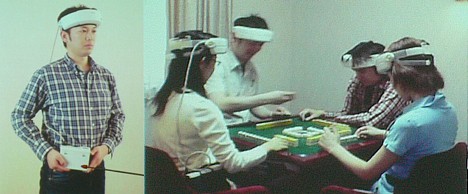
Hitachi has successfully trial manufactured a lightweight, portable brain scanner that enables users to keep tabs on their mental activity during the course of their daily lives. The system, which consists of a 400 gram (14 oz) headset and a 630 gram (1 lb 6 oz) controller worn on the waist, is the result of Hitachi's efforts to transform the brain scanner into a familiar everyday item that anyone can use.
The rechargeable battery-operated mind reader relies on Hitachi's so-called "optical topography" technology, which interprets mental activity based on subtle changes in the brain's blood flow. Because blood flow increases to areas of the brain where neurons are firing (to supply glucose and oxygen to the tissue), changes in hemoglobin concentrations are an important index by which to measure brain activity. To measure these hemoglobin concentrations in real time, eight small surface-emitting lasers embedded in the headset fire harmless near-infrared rays into the brain and the headset's photodiode sensors convert the reflected light into electrical signals, which are relayed to the controller.
The real-time brain data can either be stored in Flash memory or sent via wifi to a computer for instant analysis and display. A single computer can support up to 24 mind readers at a time, allowing multiple users to monitor brain activity while communicating or engaging in group activities.
In addition to health and medical applications, Hitachi foresees uses for the personal mind reader in fields such as psychology, education and marketing. Although it is unclear what neuromarketing applications the company has in mind, it is pretty clear that access to real-time customer brain data would provide marketers with a better understanding of how and why shoppers make their purchasing decisions. One can also imagine interactive campaigns that, for example, ask customers to think positive thoughts about a certain product in exchange for discount coupons or the chance to win a prize.
The technology could also be used in new forms of entertainment such as "mind gaming," where the player's physical brain activity becomes a part of game play. It is also feasible to integrate the brain scanner with a remote control brain-machine interface that would allow users to operate electronic devices with their minds.
Hitachi has yet to determine when the personal mind reader will be made commercially available.
[Source: Tech-On!]
 Hakuhodo DY Group i-Business Center and IT DeSign have developed "movie QR code," a type of QR code that incorporates moving video into the design.
Hakuhodo DY Group i-Business Center and IT DeSign have developed "movie QR code," a type of QR code that incorporates moving video into the design.
QR code is a type of two-dimensional barcode that has grown popular in Japan in recent years, because it provides a simple, automated way for users to enter data into their mobile phones. By using mobile phones to scan QR code that appears in an outdoor advertisement, for example, users may be directed to a website containing more detailed product information.
To personalize the appearance of printed QR code, which looks like a chaotic arrangement of tiny black and white squares, IT DeSign recently developed "Design QR," which incorporates static images of logos, characters or photos into the code. Movie QR code takes this concept a step further by incorporating moving images into the design, thus optimizing it for use on video screens, where it promises to be more effective in attracting the attention of potential scanners. Seriously, how will anyone be able to resist scanning a bit of on-screen QR code if, for example, it contains a cute, bug-eyed critter that literally begs you to scan it?
Movie QR code works just like standard QR code -- any user armed with a reader-equipped cellphone can scan it.
On May 21, the companies plan to launch a new type of advertising service built around the use of movie QR code. Details of the service will be announced soon.
Interestingly, a commercial video containing QR movie code has been circulating the web for a while. The video, called "Kung Fu High School Girls" (Kanfuu Joshi-kousei), begins with two high school girls talking about Black Jack (the famous manga character), who they both think is cool. Things quickly turn ugly when the girls disagree about whether Black Jack is a foreigner or Japanese, and a full-on kung fu battle ensues. After a while, a boy wearing a giant QR code headpiece arrives on his bicycle and urges the girls to stop. By scanning his face, he explains, they can find the answer to their question and settle their dispute. (This is a cue for the viewer to scan the computer screen with a cellphone QR code reader.)
Scanning the movie QR code takes you to http://aniful.jp/pr/ (which appears to be accessible only by keitai), where there is a link to another video that contains the answer. For some reason, the Pink Tentacle keitai is having problems downloading that video, so we may never know the truth. Is Black Jack Japanese? Or a foreigner?
[Sources: IT Media, "Kung Fu High School Girl" video (non-YouTube version)]
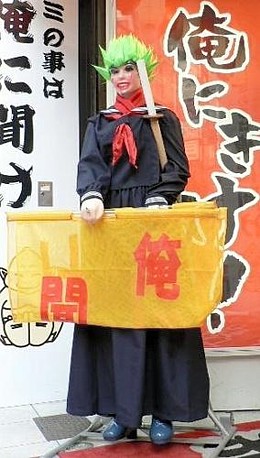 Robots can get away with things that humans cannot. In the Minami area of Osaka, for example, a humanoid robot dressed in a "sailor suit" high school uniform now works the street as a tout for an adult information center that navigates potential customers to local sex clubs. Humans in Osaka are prohibited by law from engaging in such nefarious activity.
Robots can get away with things that humans cannot. In the Minami area of Osaka, for example, a humanoid robot dressed in a "sailor suit" high school uniform now works the street as a tout for an adult information center that navigates potential customers to local sex clubs. Humans in Osaka are prohibited by law from engaging in such nefarious activity.
Since 2005, Osaka law has banned sex club touts from soliciting business on the street. The law also applies to the staff of adult information centers, which guide customers to local establishments such as love hotels, fashion-health massage parlors, cabaret clubs and image clubs. There are 175 of these adult information centers in Osaka prefecture -- more than in any other prefecture in Japan.
But despite the law change, touts have remained on the streets, albeit with slight changes in behavior. Instead of relying on their voice to solicit customers, the touts began to work the streets in silence, using gestures and holding up bright yellow "Ask me!" (Ore ni kike!) signs. Some businesses also made "Ask me!" jackets for their staff. In this way, solicitors have been able to skirt the law by letting potential customers do the approaching.
However, at the end of last month, Osaka law enforcement ordered all sex industry touts to stop carrying signs.
The response this time? Hire a robot to carry the sign. At least, that's what one adult information center has done. The human-sized robo-tout, who used to direct traffic around construction sites, underwent a 500,000 yen ($4,000) upgrade for its new job, which is to attract the attention of passersby by periodically raising and lowering a banner that reads "Ask me!"
The droid's employer foresees no run-ins with the law. "It's a robot, so no problem," says a spokesperson for the information center.
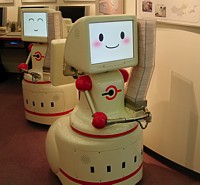 Mospeng-kun is a tissue-dispensing robot created by InterRobot Inc., a robot development and rental company based in western Japan.
Mospeng-kun is a tissue-dispensing robot created by InterRobot Inc., a robot development and rental company based in western Japan.
When the friendly Mospeng-kun detects a person nearby, it utters a high-pitched onegai shimasu and offers up a pack of tissues. When the tissues are taken from the robot's hand, it thanks the customer with an arigato gozaimashita and grabs another tissue pack from the cartridge for the next person.
InterRobot's rental fees start at 100,000 yen ($835) for 5 days, which is quite a bit more than the going rate for a human tissue distributor. But Mospeng-kun looks to be a cheerful worker, constantly maintaining a smile on its face monitor. In addition, according to the company website, Mospeng-kun is capable of gathering information about the people it encounters on the job. Unfortunately, though, the robot really needs to learn to work faster before it is ready for the sidewalks of Shibuya. Watch the video.
![]() The NTT Group has unveiled technology that analyzes the interest level of TV viewers and web surfers by monitoring their eye movement, pupil size and blinking.
The NTT Group has unveiled technology that analyzes the interest level of TV viewers and web surfers by monitoring their eye movement, pupil size and blinking.
Improving on conventional eye-tracking systems that provide an understanding of where viewers cast their gaze, this new computer-operated system features cameras that monitor and analyze unconscious physiological reactions to interesting viewing material -- namely, enlarged pupils and changes in the rate of blinking.
The technology, which became commercially available on March 14, was developed by NTT Learning Systems (NTTLS) and the Visual Interactive Sensitivity Research Institute (VIS), both of which are involved in visual content creation. NTTLS says the technology can be used in conjunction with driver safety training videos, and negotiations with a major automaker are now underway.
NTTLS claims the system appeals to a wide range of potential users, including those involved in TV commercial advertising and web content creation. Television audience ratings alone do not provide producers a clear picture of the level of interest in commercials, and web traffic stats do not show which parts of a web page visitors find interesting. With this system, however, producers can get a more accurate understanding of what the audience is looking at and how interesting they find it.
Judging from the large size (and presumably high cost) of the device that sits between the viewer and the monitor, though, the system is clearly designed for use in the laboratory. But it's just a matter of time before this is standard computer monitor/TV screen equipment and producers keep one eye on the real-time audience pupil data while they develop and deliver content.
[Source: Asahi]